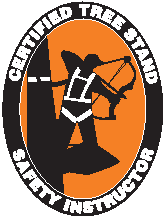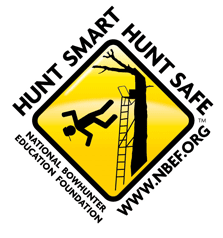AHEA Timely News
Elevated Hunting just got a little more interesting…A new crop of safety certified Treestand Safety Instructors is available to certify you also! 25 Instructors from all over Alabama are ready to teach you what you must know if you climb.By Norman Morrison Treestand safety is a primary lesson of our any Hunter Education program taught in the 50 states by the fleet of volunteer instructors, yet with the multitude of other crafts that we teach, often times, we don’t stress enough it’s importance.In September of 2010, I was privileged to attend a two day Treestand Safety Instructor’s course near Cullman Alabama at Camp Meadowbrook. In a year punctuated by no appreciable rain for the bulk of the record hot summer months in many parts of the state, the leaves on the white oak trees turning prematurely brown, our treestand outing was interrupted only briefly by welcome morning showers. By the time we put on our full body safety harnesses to demonstrate what we had learned after lunch, not a drop of water remained. The course was taught by John Louk of the Treestand Manufacturers Association, (TMA) and LJ Smith, famed early proponent of treestand safety, and much sought after treestand accident investigator. You can find plenty of references to Smith and the TMA online. The course was made possible by tireless work of the former president of the Alabama Hunter Education Association, Ricky Moss, and Stuart Goldsby, Regional Hunter Education Coordinator, along with others from the area. To be honest, when presented with the opportunity to attend the seminar, I balked. While I always enjoy a chance to meet up with my fellow instructors, I reasoned, what possible new thing could I be taught about tree stands, having used and taught about them for most of my adult life? My skepticism lasted for about five minutes into the course.
The first thing we learned was that there have been no verified deaths resulting from falls when a hunter was properly installed into a proper full body harness of the modern type. The stats go on:
One thing to take away from the stats above is to consider that the ages of the hunters most often falling from their perches is a group that is not mandated by law to receive hunter safety training. Thus, our best way to get to these people are through their kids that come through our courses. Tree stands started to become an item in the mid 60’s. If you are old enough, you probably constructed your own homemade tree stands out of bed frames and plywood. Manufactured tree stands debuted with the LOC-ON Treestand Company, and the Baker Treestand Company in prominence at this time. Today there are more than 1.5 million stands (with harnesses) sold each year. The treestand industry is big business with a capital B. Note that tree stands come with full body harnesses… This is a very important point. In 1995, far seeing treestand manufactures came together in Atlanta, Georgia and formed the Treestand Manufacturers Association to establish standards for the industry. Currently, there are over 500 stands and harnesses that meet or exceed TMA’s standards. Approximately 85% (43 companies) of the industry are currently members of the TMA. Besides setting industry standards, the TMA is obviously the education wing also, as demonstrated by the Treestand Safety course and certifications. Again, much more can be learned about the industry certification process by visiting TMA’s website. The prime safety directive of the TMA is that you must follow the manufacturers directions. This means that you must actually read and apply the directions that come with your climbing and safety equipment. The TMA also stresses that the full body harness, which comes with ALL new treestands is NOT an accessory…It is an integral part of ALL tree stands. Obviously, if your older stand didn’t come with a full body harness, you need to purchase one and use it before next you climb. Even with the latest safety devices, it must be stressed that all risk associated with going vertical in a tree can not be fully eliminated. Still, there are measures that can and should be taken to minimize peril in the event of a fall. It takes approximately 70 seconds longer to climb a tree with a harness than without. How much you value your health will determine if you’re willing to take those extra seconds. A nifty formula to consider with your students: Body weight times Distance of Fall equals your perceived weight when you land. (This is my version, but it’s good enough)… BW x D = W …. Example: You weigh in at 200 pounds. You fall 10 feet. You feel like you weigh 2000 pounds when you bounce off the loamy forest soil beneath your tree. The ground comes up mighty fast when you flip out of your stand… So fast that it is impossible to prepare for it. By the time you are on the ground, with your high school physics lesson catching up with you, your brain still thinks it’s safe in the tree. On the positive side, the above is one of the best arguments for humane death by hanging. By the time you feel the trap door swing out from under you, you’re already quite dead. It has to do with reaction times. In a fall situation, things happen faster than the mind can react to, unless you are very high indeed, which poses it’s own problems. Most people have a comfort threshold when climbing. When you feel like you are as high as you can stand, go no further, for you still must be able to operate comfortably at altitude, and you still must come down. When hunting from an elevated stand, you must make triply sure that you have followed through with a rescue plan. If nobody knows where you are, you can’t be rescued in the event of a fall, and a fall, even a successfully restrained fall can eventually result in death. A phenomena that occurs to hunters dangling in their full body harnesses…(NEVER EVER wear the old belt type harness. If you have one, burn it.) is death by “Suspension Trauma.” The problem, even if one falls gently into their harness is that the blood flow in the legs is hampered or outright suspended by the action of the harness. Over a short period of time your blood pressure goes up as the heart can’t properly circulate the blood in your body. If you can’t get back into your stand, or safely reach the ground, at some point you will die. The importance of an escape plan can not be overstated. Even if help is just a hollow away, you are in serious trouble the instant your harness deploys. Whether it’s a walkie talkie, or whistle, you and your partner should be ready, and in agreement about the eventualities. If you are hunting alone, the price of being without a plan that works can be your life. The treestand safety course gives hints of how to prepare a plan, but in the end, relies on the good common sense of the stand user. In other words, your life is in your hands when you climb. There are devices on the market that will let you safely lower yourself from a fall. Also, there is a device that you can hook directly to your harness that you can step into and will give you a measure of relief to let the blood flow to your legs again while you wait on help. It’s not the scope of this article to go into detail. The details can be found in the Treestand Safety Instructors course that is available to you now. It’s things you need to know for your own protection, as well as that of your students. A dead instructor teaches no more classes, as the saying goes. I must repeat, the course that is now available to you goes into a great deal of depth with concrete answers on most issues, I need to stress that under all circumstances, you must have and follow the manufacturers guidelines as to the use of your climbing and fall arrest products. If you don’t have the instructions, you can probably get them by visiting the TMA website.
Also worth noting… Should you, good person that you are, let your friend hunt in your homebuilt, or sell your old manufactured stand without also providing the original manufacturers instructions, and something unfortunate happens, then a new word often must be learned, and that word is…Litigation. Nothing personal of course. Yes, I was skeptical about what more I could possibly be taught about treestands. Well, I got an earful, and I feel mighty fortunate. You will too. Make use of the new crop of Treestand Safety Certified Instructors to enlighten and educate you. As we often tell our students, “What you don’t know might be the thing that gets you into trouble.” As professor John Louk of TMA says, “No shock and awe PLEASE.” Just teach them what they must know, stress the manufacturers information, and it will all make sense. Contact Ray, Stuart, or Marisa to get you hooked up with the closest instructors.
|


